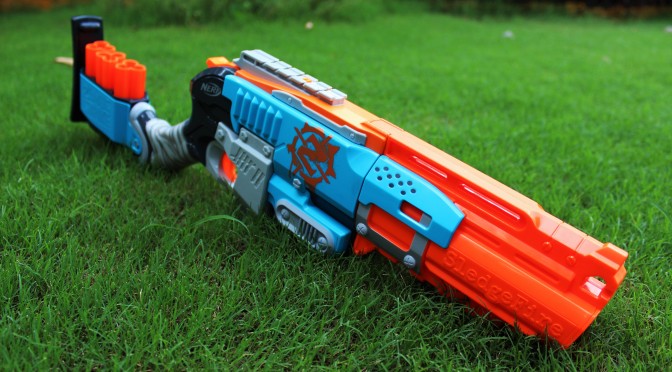Nerf as a hobby encapsulates a lot of aspects of what people call ‘Nerfing’. It can be anything from performance modding, to cosmetic modding, to organized competitive games or even office wars. However different these areas might be, one thing that all aspects of this hobby share is having fun. And there is perhaps no other blaster that conveys this notion in a better way than the Sledgefire. It’s slow to reload, takes shells which aren’t sold separately, and has mediocre performance, but it’s still a much loved blaster for one simple reason; it’s fun to play with.
The Box
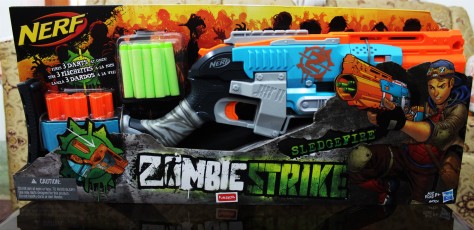
First launched in 2013, the Sledgefire, along with the Hammershot, was the first blaster to be released under the Zombie Strike line. The open face box shows the blaster itself, the shells in the stock and 9 Zombie Strike darts. Inside the box are the instructions and a few cardboard stencils.

First Impressions, Aesthetics and Ergonomics
For a ‘shotgun’ class blaster, the Sledgefire is surprisingly sleek and very well designed, right down to the snakeskin texture grip, the ‘kill-count’ markings, various vents and ridges and fake over-sized screws. Neon colours aside, it looks great and it feels great. The grip is large enough for adult sized hands, and the stock, although a bit small for me, is comfortable and contoured.
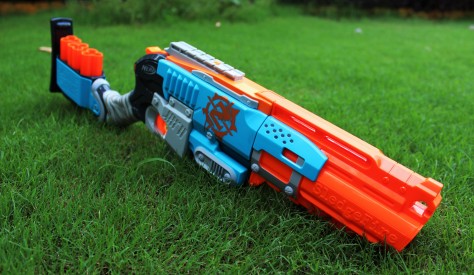
Performance and Use
To fire the blaster, break the barrel, insert a shell, and fire. The empty shell pops out a little bit to make reloading easier. Shells don’t eject completely so there’s no fear of losing them.
Range
Testing had to be changed a little bit owing to the fact that the Sledgefire can work with one, two or three darts in the shell. The blaster was fired 3 times from shoulder height both parallel and angled to ground. Three sets of values were made for every iteration and averaged. Darts that came with the blaster and some slightly used elite darts were used in the testing. No accuracy test because, well, shotgun. Performance is meh at the very most, but hey, its firing 3 darts at once.
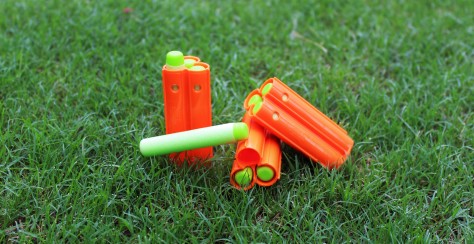
Parallel to Ground
i) Full shell
High- 41 feet
Medium- 36 feet
Low- 30 feet
ii) 2/3 shell
High- 44 feet
Medium- 36 feet
Low- 32 feet
iii) 1/3 shell
High- 48 feet
Medium- 42 feet
Low- 33 feet
Angled to Ground
i) Full shell
High- 51 feet
Medium- 44 feet
Low- 40 feet
ii) 2/3 shell
High- 52 feet
Medium- 44 feet
Low- 39 feet
iii) 1/3 shell
High- 52 feet
Medium- 46 feet
Low- 43 feet
Rate of Fire
Considering it’s a break-action blaster that takes shells, I wasn’t expecting a very high rate of fire. I managed to fire all 3 shells in about 6 seconds on an average. Nothing groundbreaking, especially when this now exists.
Reliability
In my extensive testing, the blaster didn’t fail to fire, however, if it was jostled around , the darts in the shell popped out a bit, resulting in a misfire or darts just dropping out of the barrel. Darts that had a better fit were unaffected.
Overall Opinion
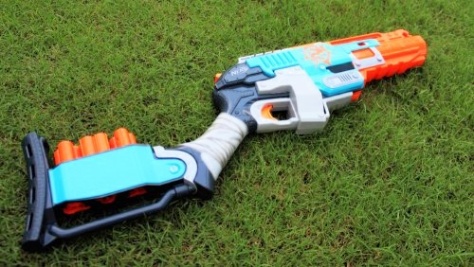
Modders have taken quite a liking to the Sledgefires owing to their rather large plunger tube and its shotgun capabilities, turning them into singled shooters that hit like a truck, or even next level air powered shotguns. But even in its stock form, the Sledgefire is everything the hobby is about, and that is to have fun.
